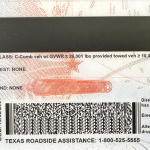In the modern – day society, the issue of fake IDs has been a persistent concern, and as we approach 2025, the role of law enforcement databases in identifying these counterfeits becomes even more crucial. Fake IDs are not just a minor nuisance; they have far – reaching implications for public safety, security, and the proper functioning of various systems.
The Landscape of Fake IDs in 2025
In 2025, the technology available for creating fake IDs has become more sophisticated. Counterfeiters are leveraging advanced printing techniques, high – quality materials, and digital manipulation tools. They are able to replicate many of the features of legitimate identification documents, such as holograms, microprinting, and UV – reactive inks. This has made it increasingly difficult to detect fake IDs at a glance.
Moreover, the demand for fake IDs continues to grow. Young people may seek fake IDs to gain access to age – restricted venues like bars and clubs, while others may use them for more nefarious purposes, such as identity theft, fraud, or illegal immigration. The black market for fake IDs has expanded globally, with counterfeiters operating across borders and using the internet to sell their products.

The Importance of Law Enforcement Databases
Law enforcement databases play a pivotal role in the fight against fake IDs. These databases are comprehensive repositories of information related to legitimate identification documents. They contain details such as the design specifications of various IDs (driver’s licenses, passports, etc.), the personal information of individuals associated with those IDs, and records of previous fake ID cases.
One of the key functions of these databases is to provide law enforcement officers with a reference point for comparison. When an officer suspects an ID to be fake, they can access the database to check for discrepancies. For example, if the design of a driver’s license in hand does not match the design specifications stored in the database (such as differences in the font, color, or placement of elements), it could be a sign of a counterfeit.
Law enforcement databases also help in tracking trends in fake ID production. By analyzing the data from multiple fake ID cases, authorities can identify patterns in the types of IDs being counterfeited, the regions where they are most prevalent, and the methods used by counterfeiters. This information can then be used to develop more effective prevention and detection strategies.

How Law Enforcement Databases Identify Counterfeits
There are several ways in which law enforcement databases assist in identifying counterfeits. First, through biometric data. Many modern identification documents now include biometric features such as fingerprints, facial recognition data, or iris scans. Law enforcement databases store this biometric information, and when an ID is presented, the biometric data on the ID can be compared with the data in the database. If there is a mismatch, it is a strong indication that the ID is fake.
Second, through the use of unique identifiers. Each legitimate identification document has a unique number or code associated with it. Law enforcement databases keep track of these identifiers and can quickly determine if an ID number has been tampered with or is associated with a stolen or fake ID. For example, if an ID number is found to be duplicated across multiple IDs in the database, it is likely that at least some of those IDs are counterfeit.
Third, through advanced image – matching algorithms. Law enforcement databases can store high – resolution images of legitimate IDs. When an officer needs to verify an ID, they can upload an image of the suspect ID to the database, and the system will use image – matching algorithms to compare it with the stored images. Any differences in the image, such as blurriness, pixelation, or irregularities in the printed elements, can be detected, helping to identify counterfeits.

Challenges Faced by Law Enforcement Databases in Fake ID Detection
Despite their importance, law enforcement databases face several challenges in the detection of fake IDs. One major challenge is the issue of data security. These databases contain highly sensitive information, and protecting them from cyber – attacks is of utmost importance. Counterfeiters may try to hack into these databases to obtain information that can help them create more convincing fake IDs. Law enforcement agencies need to invest in robust security measures, such as encryption, access controls, and intrusion – detection systems, to safeguard the data.
Another challenge is keeping the databases up – to – date. As new types of identification documents are issued, or as the design of existing IDs is updated, the databases need to be revised accordingly. Failure to do so can lead to inaccurate comparisons and missed detections of fake IDs. This requires close cooperation between the agencies responsible for issuing IDs and those managing the law enforcement databases.
There is also the challenge of interoperability. In a globalized world, law enforcement agencies from different countries may need to share information about fake IDs. However, different databases may use different formats and standards, making it difficult to exchange data seamlessly. Developing common standards and protocols for data sharing is essential to overcome this challenge.
Collaboration and Information Sharing
To enhance the effectiveness of law enforcement databases in identifying counterfeits, collaboration and information sharing are key. Law enforcement agencies at the local, state, and national levels need to work together. For example, local police departments can report fake ID cases to state – level databases, which can then share the information with national databases. This way, a comprehensive picture of the fake ID problem can be built, and resources can be allocated more effectively.
International collaboration is also crucial. Counterfeiters often operate across borders, and sharing information between countries can help in tracking down these criminals. Interpol and other international law enforcement organizations play a vital role in facilitating this information exchange. They can also help in coordinating joint operations to target fake ID production and distribution networks.
Moreover, collaboration with the private sector can be beneficial. ID – issuing companies and technology providers can share their expertise and insights with law enforcement agencies. For example, they can provide information about the latest security features in ID documents and help in developing more effective detection tools.
Common Problems and Solutions
Problem 1: Inadequate Training of Law Enforcement Officers
Many law enforcement officers may not be fully trained in using law enforcement databases for fake ID detection. They may not be aware of all the features and functions of the database, or they may not know how to interpret the results of a database search accurately.
Solution: Regular and comprehensive training programs should be implemented. These programs should cover all aspects of using the law enforcement database, including how to access it, how to perform different types of searches, and how to analyze the results. Hands – on training with real – life examples of fake and real IDs can also be very effective in improving officers’ skills.
Problem 2: Outdated Database Information
As mentioned earlier, if the law enforcement database is not updated regularly, it may contain inaccurate or outdated information. This can lead to false positives or false negatives in fake ID detection.
Solution: Establish a dedicated team or process for keeping the database up – to – date. This team should be responsible for monitoring any changes in ID design, new security features, or updates in personal information. They should also have the authority to make the necessary changes to the database in a timely manner.
Problem 3: Slow Database Response Times
In some cases, the law enforcement database may have slow response times, especially during peak usage periods or when performing complex searches. This can delay the process of fake ID detection, and in some cases, may even lead to officers making hasty decisions without waiting for the database results.
Solution: Invest in upgrading the database infrastructure. This may include improving the server hardware, optimizing the database software, and implementing caching mechanisms to reduce the load on the database. Additionally, load – balancing techniques can be used to distribute the workload evenly across multiple servers.
Problem 4: Lack of Public Awareness
The general public may not be aware of the dangers associated with fake IDs and the role of law enforcement databases in detecting them. This can lead to people being more likely to use or obtain fake IDs, and also less likely to report any suspicious activities related to fake IDs.
Solution: Launch public awareness campaigns. These campaigns can be carried out through various channels, such as social media, schools, community centers, and local newspapers. The campaigns should educate the public about the legal and social consequences of using fake IDs, as well as how they can contribute to the fight against fake IDs by reporting any suspicious behavior.
Problem 5: Difficulty in Verifying International IDs
When dealing with international IDs, law enforcement officers may face difficulties in verifying their authenticity using domestic law enforcement databases. This is because different countries have different ID design standards and security features.
Solution: Strengthen international cooperation and data – sharing agreements. Law enforcement agencies should work together to create a more comprehensive international database of legitimate IDs. This database should include information about the design and security features of IDs from different countries. Additionally, training programs can be developed to help officers understand the differences in international IDs and how to verify them.
Problem 6: False Alarms
The use of law enforcement databases may sometimes result in false alarms, where an ID is flagged as fake when it is actually legitimate. This can cause inconvenience to the ID – holder and may also waste law enforcement resources.
Solution: Continuously improve the accuracy of the database algorithms and search mechanisms. This can be done by analyzing past false – alarm cases and making adjustments to the database’s matching criteria. Additionally, having a secondary verification process in place can help to reduce the number of false alarms.
Problem 7: Resistance to Database – Driven Detection
Some law enforcement officers may be resistant to relying too much on law enforcement databases for fake ID detection. They may prefer to use their own experience and intuition, which can sometimes lead to inconsistent detection results.
Solution: Provide clear guidelines and training on the proper use of law enforcement databases. Emphasize the importance of using the database as a tool to supplement, not replace, officers’ experience and judgment. Highlight the benefits of database – driven detection, such as increased accuracy and the ability to detect patterns.
Fake ID Pricing
unit price: $109
| Order Quantity | Price Per Card |
|---|---|
| 2-3 | $89 |
| 4-9 | $69 |
| 10+ | $66 |


